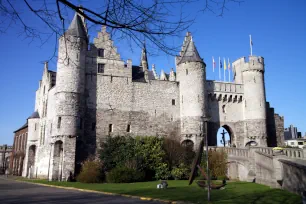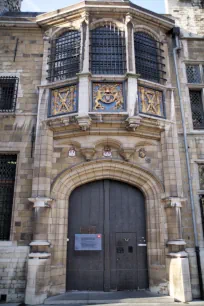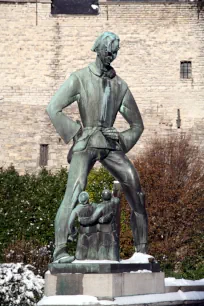The oldest building in Antwerp is an 800-year-old castle known as ‘t Steen (the stone). What remains today is only a fraction of the once mighty castle that formed the nucleus of the city.




Now standing rather desolate at the quays, the building was once the center of the city’s oldest neighborhood – known as the Oude Werf – with narrow streets, gates, towers and a fish market.
The thirteenth-century Castle
The Steen was built around the year 1200 at the site of an older, 9th century fortress. It was named Steen as it was the first large building constructed in stone. What we see now is only a small part of this castle, which at one point was almost six time the current size. It served as the home of the burgrave of Antwerp and included a church (St. Walburgis), a courthouse, a warehouse, a monumental gate and several other buildings. The complex was surrounded by a large defensive wall.
Sixteenth-century Renovation
The Steen was altered several times during history, most notably in 1520 when Emperor Charles V ordered a thorough renovation of the castle, carried out by the architects Rombout Keldermans and De Waghemakere, both of whom also worked on the construction of the cathedral. The chapel above the entrance dates from this period. It is very easy to see which part of the castle is still original: the thirteenth-century masonry is much darker than that of the sixteenth century, hence the two-colored tone of the front facade.
From 1549 until 1823 the building served as a prison and in 1862 it became an archaeological museum.
Escape from Demolition
In the nineteenth century, the city decided to widen the river and construct new quay walls to accommodate the growing harbor traffic and to prevent the river from becoming silted up. The only problem? The whole historic center around the castle had to be demolished. Since the harbor was considered of vital importance for the future of the city, the project went ahead nonetheless. During the construction of the new quays, more than five hundred buildings were demolished. The Steen survived – barely; the city council voted in favor by just a single vote – and was renovated between 1889-1890. Still, most of the castle was demolished, and only the gate and burgrave’s house now stand stranded at the quay.


The Steen Today
The most imposing remainder of the original castle is the entrance gate. Above the entrance gate is a small statue of Semini, a pagan god of youth and fertility. According to local legend, he was the forefather of the people of Antwerp. In 1587 the Jesuits, a fanatical religious order, mutilated the nude statue.
An inclined ramp leads to a small inner courtyard, the only part that remains of a network of eight streets. The east side of the castle shows a colorful relief with the emblem of Charles V.
Until the end of 2008 the Steen was home to the National Maritime Museum. Its collection moved to the new MAS museum. The Steen now functions as cruise terminal / visitor center for large cruise ships. In 2021 a bland and rather unsightly modern pavilion was built against the walls of the castle to house a tourist information center.
Lange Wapper
Near the entrance of the castle stands one of Antwerp’s most famous statues: the Lange Wapper. The statue, created by local sculptor Albert Poels in 1963, depicts the legendary figure of Lange Wapper who, according to Antwerp folklore, could grow to the size of an enormous giant. He was said to have a devilish character and enjoyed teasing people.
- Next: City Hall
- More Sights & Attractions in Antwerp

